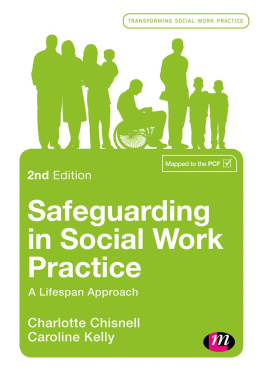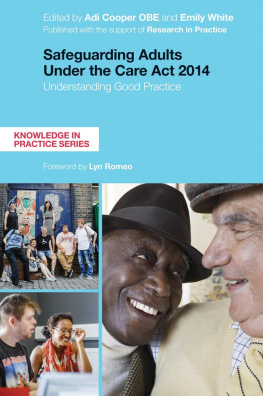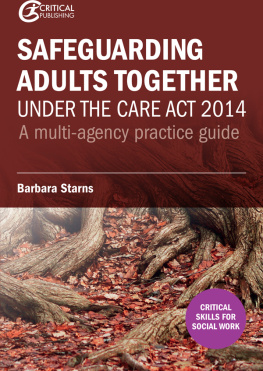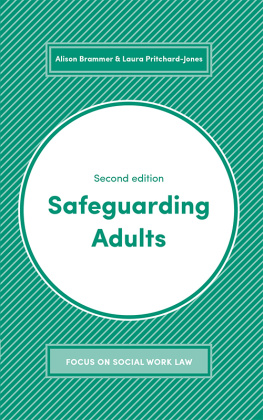Introduction
Issues and challenges for safeguarding in the social and health care context
This book is about adult safeguarding, a term used to refer to the protection from abuse or neglect of vulnerable adults. At one extreme, abuse and neglect may be associated with reckless, sadistic, bullying, dishonest and opportunistic individuals, who may be known to the victim or sometimes strangers who deliberately pick on vulnerable adults. There is also more systemic neglect perpetrated or tolerated by institutions and organisations, including NHS hospitals and independent care providers. Equally, neglect might result when a family member, faced with the difficult task of caring, might become so worn down and overwhelmed that the informal care being provided becomes neglectful, albeit unintentionally.
The book limits itself to abuse and neglect suffered by adults who in a sense are vulnerable. This is a term eschewed by the Department of Health and is consequently absent from the Care Act 2014, the central legal pillar of adult safeguarding. Yet, paradoxically, the word vulnerable remains important in adult safeguarding because it occurs in other relevant legislation and is used frequently by the courts in various, and important, legal judgments. The Care Act refers instead to adults with care and support needs who experience, or are at risk of, abuse or neglect. Which category of person, in all but name, covers those people who are vulnerable.
Aim of the book
The book aims to assist not just professionals and practitioners in statutory services, including local authorities, the National Health Service, police, voluntary bodies, professional bodies and independent providers, but also others, such as family members, who sometimes feel compelled to undertake their own safeguarding activities in order to try to prevent abuse or neglect, put a stop to it if it is already occurring, or try to hold somebody accountable after the event. And who unexpectedly find themselves dealing with legislation they had not known existed, and sometimes grappling with both complex legal rules and evasive organisations seeking to avoid that accountability.
Scope of the book
The focus is on England. It would be impractical, in a book of this nature and detail, to cover all four countries within the United Kingdom. Even within England, the amount of law is significant and inevitably the book is selective to a degree. Nonetheless, there is some legislation that is common across the United Kingdom, such as the Human Rights Act 1998; other legislation has differences but also many similarities for example, the Care Act 2014 applying to England and the Social Services and Well-being (Wales) Act 2014.
Content of the book
The book covers an extensive amount of legislation and other law relevant to adult safeguarding. However, such law comes to life only when seen in action. Therefore, the book makes reference to, and provides summaries of, many legal cases to give substance to legal rules and their application to everyday practice.
The cases could be viewed as painting an unremittingly gloomy and depressing picture, but if adult safeguarding is to make headway, it needs to know what it is up against. Furthermore, the awful circumstances of abuse or neglect do need to be spelt out. For example, it was only the graphic descriptions of neglect, set out in the independent inquiry into events at Stafford Hospital, that blew away irrevocably the web of denial, evasion and euphemistic explanation of the hospitals management, the strategic health authority and the Department of Health.
Background to adult safeguarding
In the early 1980s, adult safeguarding or adult protection as it was and is sometimes still called was recognised, explicitly in its own right, neither in policy nor in law. By the early 1990s, it had raised its head hesitantly in two publications by the Social Services Inspectorate, then part of the Department of Health in England: Confronting elder abuse and No longer afraid . During the 1980s and 1990s, child protection would dominate, just as, generally speaking, it continues to do.
The Department of Health had missed the boat in 1990, when it failed to refer to adult safeguarding in the NHS and Community Care Act of that year. By 2000, finally, it felt moved to act but appeared too nervous and uncertain about putting anything in law. Instead, it produced statutory guidance called No secrets .
The strength of this guidance lay in its formal recognition of adult protection and the increased focus in practice on safeguarding activity that followed its publication. Its weakness was that it did not constitute law and did little to explain how it related to the community care legislation existing at that time. Consequently, for the following 15 years, the legal foundation of adult safeguarding remained muddy and despite all the valuable and well-intentioned work of local authorities subject to uncertainties.
During this time, the Scottish Parliament stole a march and passed the Adult Support and Protection (Scotland) Act 2007, with explicit definitions and legally enforceable powers of entry and intervention. Lagging behind, the Care Act 2014 finally placed adult safeguarding in England on a statutory footing, although with less clarity and conviction and with fewer legal powers than in Scotland. The Social Services and Well-being (Wales) Act 2014 also contains adult safeguarding provisions, with Welsh local authorities being given more legal power (in particular, a power of entry to a dwelling) than their English, but less than their Scottish, counterparts.
Therefore, a remaining question about adult safeguarding in England is whether further legislation is needed, giving local authorities some sort of last-resort coercive power of entry and intervention, in relation to vulnerable adults generally, with or without mental capacity.
Salient and troubling aspects of adult safeguarding
The book depicts generally an unflattering side of human behaviour underlying both the perpetration of and sometimes more concerningly the response to the abuse and neglect of vulnerable adults, whether that perpetration and response are individual or organisational in character. Over and above this, and during the researching and writing of the book, a number of issues have stood out which are distinctly troubling. They pertain not just to adult safeguarding narrowly viewed but more widely to the system of social and health care. The paragraphs below seek to encapsulate these issues.
SOCIAL SERVICES: ITS UNCERTAIN AND DIVERGENT ROLE . Local authority social services sit at the centre of adult safeguarding, with the Care Act 2014 the legal foundation stone. However, the role of social services is by no means straightforward and is characterised by legal complexity, uncertainty and sometimes misunderstanding.
First, protecting people from abuse or neglect applies under the Care Act 2014 to adults with care and support needs, and their informal carers, only. And since the meaning of care and support has been held legally to be of broad application, there is some uncertainty as to how to define the categories of adult covered by the Act.
Furthermore, the Care Act 2014 is not a coercive piece of legislation, meaning that social services cannot force anybody victim, perpetrator or another organisation to do anything. Under the Act, social services makes enquiries into abuse or neglect, can request cooperation from other bodies and more generally can offer information, advice, care and support services, but cannot directly do much else in a wider sense.










